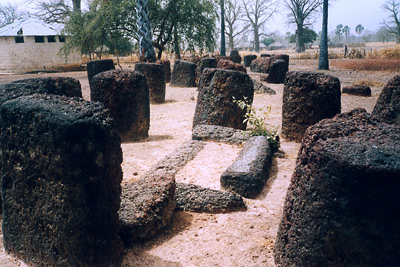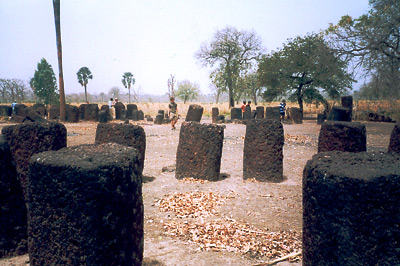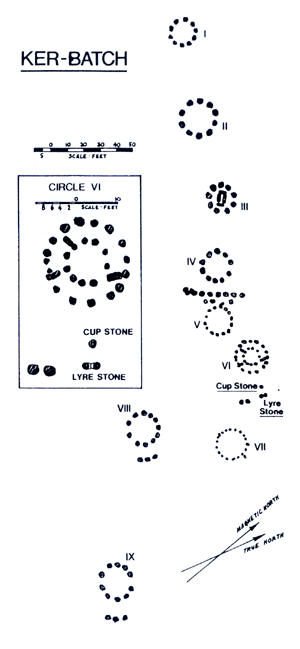|
|
Stone circles of The Gambia

Wassu Stone Circles

Like the Pyramids and Temples of Ancient Egypt and the ruins of Zimbabwe, the stone
circles of Senegal and the Gambia are impressive remains that have puzzled
the few travellers who have examined them. Stone circles of many types
are found throughout Europe
and the Near East, though nowhere is there so large a concentration as
found on the north bank of the river Gambia. It is fair to assume that
the presence of such a large group of monuments of a similar type in a
relatively localised setting implies the presence of a well established,
dynamic culture.
The area involved covers some 15,000 square miles between the Saloum
and Gambia Rivers. Here there are hundreds of circles containing many
curious features and in particular the unique V or Lyre stones. The
commonest shape is round like a pillar with a flat top. Others are square;
some taper upwards. There are small stones with a cup-shaped hollow
on top. Others have a ball cut in the round top of the stone. There
is a recumbent stone shaped like a pillow.
The stone circles at Kerr Batch
The Circles are composed of standing stones between ten and twenty
four in any particular circle. One of the striking feature is that almost
all the stones forming a given circle are of the same height and size.
Their height above the ground varying between two hundred and forty
five (245cm) centimetres and sixty centimetres (60cm). The diameter
is from thirty centimetres (30cm) to one hundred centimetres (100cm).
The largest stones which are at N'jai Kunda must weigh about ten tons
each. They were brought down a steep hillside and their transportation
on rollers or on hammocks must have presented formidable difficulties
and have required a considerable labour force.

The stone circles at Wassu
As a results of Laboratory tests at the University of Dakar, the date
of the sample was found to be from 750 A.D plus or minus 110 years.
The stones were cut out of laterite (" a cementation of ferruginous sandstone
") that occurs in large outcrops in this region. It is a feature of this
stone that it hardens upon exposure to the air, and that prior to such
exposure it is relatively easy to quarry.
Where several circles are found on the same site the exterior stones
form a continues line as at Wassu. Clearly there is much work to be
done in carefully surveying these extensive monuments, both in precisely
locating them on maps and measuring them in detail.
 One of the circles in Kerr Batch
A lot of explanations have been given about the shape of the Senegambia
Stone Circles by Islamic historians and wise observers.
One of such explanations was revealed by the late
Alhaji Kemoring Jaiteh a well known Islamic scholar of Kuntaur Fulla Kunda
in Niani. According to his writings, if a small stone stands near a large
one, that shows that, some one was buried with his/her child. Similarly,
if the stones are V-shape, that pictures that two close relatives died on
the same day and were buried together.
The circles are said to be built around mounds of kings and chiefs,
in the same way as royal persons were buried in the ancient empire of
Ghana.
Once Islam was brought into Senegambia in the 11th century, devout Muslims
especially the "Karamos" were also buried in the same way. Consequently,
some of these Circles became holy places.
Today, small stones and vegetables like tomatoes are still left on the
stones. Some of these stones are said to shine bright at night.

Gambian and Danish students visit the Stone Circles of Wasu in
January 2005
The Wassu Stone Circles are said to be visited by hundreds of people
annually and all-year-around and by classes of people: students,
geologists, historians, archaeologists and tourists.
A museum situated at the "Stone Circles" in Wassu Central River
Division (CRD) was inaugurated on Saturday May 27th 2000. According to a press
release issued by the
National Council for Arts and Culture, the museum
is the first of its kind in the Senegambia region which seeks to interpret
the "Stone Circle" puzzle. The Wassu museum is seen as a major success
for the Council in its drive to decentralise its services and preserve
the Gambia's cultural heritage. The release says that work on the building
was completed through the financial assistance from UNESCO and technical
support from APSO, an Irish Voluntary Organisation.
Another new museum sponsored by UNESCO was officially opened at Kerr
Batch Stone Circles in Central River Division, on Saturday the 12th
February 2005.
Wassu and Kerr Batch stone circles both in CRD in The Gambia and two
others Sine Ngayne and Wanar in Senegal are now inscribed on the
World
Heritage List of UNESCO. It is The World Heritage Committee
sitting at its 30th Session in Vilnius, Lithuania, that approved the
inscription of the Stone Circles of the Senegambia in the World Heritage
List.
In recognizing the universal significance of the Stone Circles, the
World Heritage Committee cited the fulfilment of
criteria I
and III of the World Heritage Convention's conditions for
inscription in the World Heritage List, noting that: "The finely worked
individual stones display precise and skilful stone working practices
and contribute to the imposing order and grandeur of the overall stone
circles complex." It also added that the circles "represent the wider
megalithic zone, in which the survival of so many circles is a unique
manifestation of construction and funerary practices which persisted for
over a millennia across a sweep of landscape, and reflects a
sophisticated and productive society."

Danish students visiting the Stone Circles of
Kerr Batch in February 2003
|
The following is an extract from an article "Megaliths
in the Senegambia" that appeared in The Lay Hunter in
the late 1970s |

APPENDIX: Paul Devereux.
Experiments with the Ker-Batch group.
Having the plan of Ker-Batch to hand, I thought it might prove
worthwhile to look at the circles in the light of experience gained on
the UK field-trip. We discovered that edge alignment was the rule, and
centre alignment stood out as more of an exception. Watkins also noted
this with respect to mounds, roads and circles. He pointed out that
the apparently disparately placed circles at Stanton Drew, for example,
had their common line running through their eastern edges. (There are
also, though, some interesting centre alignments at the site as well.)
At Ker-Batch, preliminary work soon showed that there was no
apparently meaningful central alignments, so edge alignment was
concentrated on. What follows is subject to the accuracy of the plan
available and the restrictions of attempting geometry at the scale of
the plan copy available; so it is all slightly `rough and ready' but
enough to show, I think, that the circles are not so randomly laid out
as might appear. I would need a lot of convincing that the underlying
geometry is pure chance.
|
|

Investigation suggested the following features.
Alignment AC touching the northernmost stones of circles I, II, III
and VI. Alignments AF and BG touching circles II, VIII and IX on their
southern and northern edges respectively, and AF touches the northern
side only of I. AF and BG are parallel. AF and AC meet at the same
stone in circle I. An alignment through the eastern edges of circles
VIII and VII extends northerly to C and cuts BG in the southwest at D
and AF at E. Both D and E are rightangles. Alignment BG not only
touches the northern edges of II, VIII and IX but also the end stones
of curved lines east of IX and VIII and the southwest stone of the
straight row between circles IV and V. Taking this last point as J,
and producing a line from there to pass between the two stone outliers
between circles VI and VII to cut EC at H, a Pythagorean triangle JHD
is formed. The direction of JH is also indicated by another stone next
to the one at J. Supporting structure for this geometry might possibly
exist in that a line from the stone at B in circle II produced through
the extreme northeast stone of the straight row and through the Cup
stone and Lyre stone also meets EC at H. Alignments to opposing edges
of circles
VI and VII cross at the southern stone of the two outliers which is
touched by JH. I do not suggest that this is the full extent of the
implied geometry.
I'm sorry that all that is a bit indigestible, but space forces me to
compress the description of the diagram presented. But parallel lines,
right angles, edge alignments affecting up to half the circles of the
group, and 3-4-5 triangles do not occur by chance in a group of 8
circles in my opinion. And when clearly constructed stone rows play
important roles in such implied geometric schemes, it is my view that
intention cannot be doubted. To the question `But why would they do it?'
I can only say that I can't explain the mesh of lines at Nasca either,
or the Bolivian lines, or the Dartmoor stone rows, and so on!
|
|
|
 Home-
Back to start page Home-
Back to start page
 E-mail Momodou Camara
E-mail Momodou Camara
Last updated on June 7th, 2025

[Me]
[Africa]
[The Bantaba][Nature Reserves]
[Culture]
[The Gambia]
[Guest book]
1996-2025 Nijii, All rights reserved. Momodou Camara |
|








